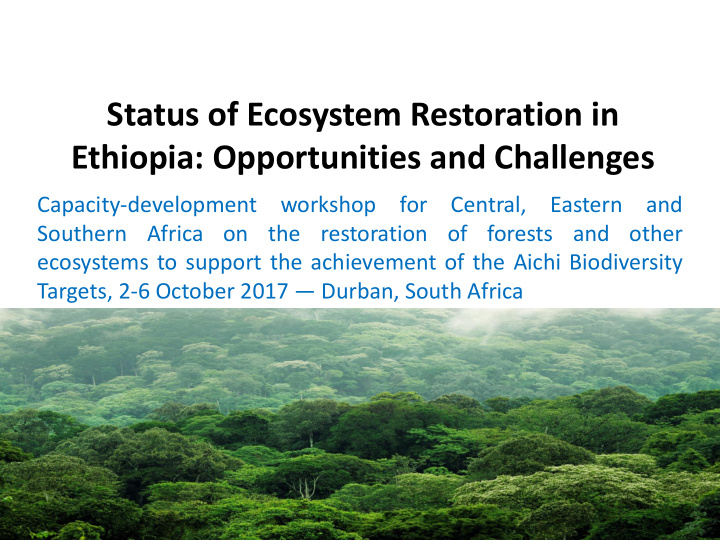



Status of Ecosystem Restoration in Ethiopia: Opportunities and Challenges Capacity-development workshop for Central, Eastern and Southern Africa on the restoration of forests and other ecosystems to support the achievement of the Aichi Biodiversity Targets, 2-6 October 2017 — Durban, South Africa
Presentation outline: 1. The CRGE strategy 2. Ecosystem restoration activities 2.1 Area closures 2.2 Aforestation 2.3 Enhancing protected area systems 4. Opportunities 5. Challenges
1. Ethiopia’s Climate -Resilient Green Economy Strategy (CRGE) • Ethiopia is implementing the CRGE strategy since 2011 with the objective of protecting the country from the adverse effects of climate change and building a green economy that will help realize its ambition of reaching middle income status before 2025. Ethiopia’s vision: ▪ Achieve middle-income status by 2025 in a climate- resilient green economy The plan: ▪ Follow a green growth path that fosters development and sustainability
CRGE strategy… ▪ Under the business as usual scenario, emissions would increase from 150 Mt to 400 Mt (2010 to 2030) The development of a green economy will be based on four pillars: ▪ Agriculture : Improving crop and livestock production practices for higher food security and farmer income while reducing emissions; ▪ Forestry : Protecting and re-establishing forests for their economic and ecosystem services, including carbon stocks
CRGE strategy… ▪ Power : Expanding electricity generation form renewable energy for domestic and regional markets ▪ Transport, industrial sectors and buildings : Shifting to modern and energy efficient technologies o Thus, the forest sector is among the dominant components of the CRGE pillars with the largest share of emission reduction next only to Agriculture.
CRGE strategy… ▪ Despite their economic and environmental value, Ethiopian forests are under threat mainly from deforestation and forest degradation ▪ Deforestation and forest degradation must be reversed to minimize the emission from the sector ▪ The CRGE initiative prioritizes the following strategies that could help to develop sustainable forestry and reduce fuel wood demand
General… ▪ Reduce demand for fuel wood via the dissemination and usage of fuel-efficient stoves and/or alternative- fuel cooking and baking techniques; ▪ Increase aforestation, reforestation, and forest management to increase carbon sequestration in forests and woodlands; ▪ Promoting area closure via rehabilitation of degraded pastureland and farmland , leading to enhanced soil fertility and thereby ensuring additional carbon sequestration.
2. Ecosystem restoration activities 2.1 Area closures ▪ In order to implement the ambitious plans of the CRGE strategy including area closure and aforestation, the government has prepared growth and transformation plan (GTP2), which is implemented during 2016-2020. ▪ Area closures planned in GTP2: 1 mill ha natural forests 5 mill ha degraded land around hydro dams
Ecosystem restoration… ▪ Establishing area closures has become common in Ethiopia, especially in northern and central highlands, where they serve as a response to persistent soil, vegetation and water degradation affecting forest resources, agricultural biodiversity and ecosystems. ▪ Ethiopia plans to rehabilitate 22 million hectares (15+7) of degraded forests and lands by 2030; ▪ Area closures contribute a lot and as widely promoted rehabilitation practices (1.5 million ha in one region only), contributed to the vegetation cover change of the country (12-15%)
Ecosystem restoration…
2.2 Aforestation ▪ Ethiopia is aggressively moving to increase the forest cover from 15% to 20% during the GTP period mainly through aforestation activities. In GTP2: 2016-2020 (21.35 bill seedlings; 4.56 mill ha) ▪ Produce 4.27 bill forest seedlings per annum; ▪ Plant nearly one mill ha of forests annually ▪ As an achievement, about 2.9 million hectares of land have been afforested with different tree species.
3. Enhancing protected area systems ▪ In NBSAPs, it was planned to increase the protected area (PA) coverage from 14% to 20% during 2015-2020; Currently, the number of PAs reached 73: ▪ 24 national parks ▪ Two sanctuaries, ▪ Five wildlife reserves, ▪ 21 controlled hunting areas, ▪ Six open hunting areas, ▪ Ten community conservation areas ▪ Five Biosphere Reserves
3. Challenges and opportunities ▪ Expansion of farming to forests (commercial and smallholder) ▪ Excessive wood extraction – mainly for fuel wood ▪ Forest fire ▪ over grazing ▪ Institutional challenges – tenure related, law enforcement, etc. ▪ Considering ecosystem services as free goods, & lack of experiences in PES
Opportunities ▪ Strong commitment from the government ▪ Strategies and guidelines to support scaling up of best forestry practices ▪ Participation of stakeholders ▪ Presence of organizational structure ▪ The wide range of ecological zones
Thank you
Recommend
More recommend